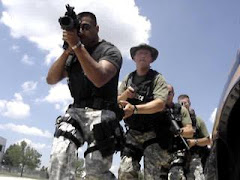“Cold Bore Shot”: Integrating “Ju” and “Shin” for more effective Life Management.
During a discussion regarding some of the lessons learned over the last decade of special operations work, I was speaking informally with a few fellow special operations team leaders from various teams and the topic of the “cold bore shot” came up. For those unfamiliar with the term, in a firearms system, the “cold bore shot” is usually considered the “first shot of the day”.
Following the "cold bore" shot, shooters may compensate for poor technique, poorly sighted weapon system, or both by adjusting their point of aim to change their point of impact (sometimes referred to as “Kentucky windage”). As a Special Operations Team Leader and Tactical Trainer, the “cold bore shot” gives me insight into the shooter at three critical levels:
· Technical/Operational level – Is my shooter using proper technique? Does my shooter have a properly sighted (“zeroed”) weapon system?
· Tactical/Strategic level – Will my shooter’s first shot be effective or does it provide a marker from which to use “Kentucky windage”? In counter-sniper missions, hostage rescue missions, and urban operations, using ineffective marksmanship as a tool to “walk” one’s rounds towards the intended target is an unsatisfactory tactic with dire ramifications.
· Mindset/Leadership level – Is there something beyond the weapon technology or operator’s skill lacking such as will? In other words, do my shooters, even though they are trained to continue actions on the target until the threat has been stopped, see each and every round fired- from first (and particularly, the first) to last- as being significant with the potential to stop the threat, secure the objective, and complete the mission?
These concepts have been reduced to a single phrase in Japanese martial arts that encompass the Operational, Strategic, and Leadership levels of analysis outlined above. This phase, ichi-go; ichi-e, captures the Zen essence of Japanese warrior training ideals and was popularized by Naosuke Ii in the 19th century work, Chanoyu Ichi-e Shu ( a text that describes the spirit of the Japanese Tea Ceremony as being one of “one encounter; one opportunity”).
Ichi-go; Ichi-e (one encounter; one opportunity) is a principle which, when applied to one’s practice, becomes the foundation of proper mindsets/attitudes (referred to as shin in Japanese martial arts). Ichi-go; Ichi-e based practice guides the student to see each repetition performed as the only repetition while it is being performed. In other words, using the example of a fire and maneuver course on a tactical shooting range, if a first shot is not perfect, there is no restarting the course – one simply follows through making the next shot the “only” shot followed by the next and the next. Similarly, for a martial artist, if during the practice of a technique, one does not maneuver correctly initially, there is no “do-over”. One simply must make the next movement “the only movement” or adapt to a different maneuver that is appropriately linked to the first movement. With practice and proper attitude, operations, strategic and leadership skills grow interdependently; the proof is in the seamless transitions that allow the expert to seem as if mistakes are never made. A “mistake” is simply seen as an alternate problem solving point and the expert simply adapts appropriately and unconsciously (termed as unconscious competence - see previous discussions on “Ju”).
This level of mastery is not only desirable at a physical level, but also (and probably more importantly) at a mental level; Seizan-Ryu teaching methods place a great deal of emphasis on the psycho-motor aspects of training that develop mental adaptability as well as physical skills flow. These methods are present at all levels of all training programs at Seizan Ryu Academies. The methods include systematic instruction that is exacting in its technical nature, but simultaneously conceptual in a manner such that the student absorbs the “whole picture” and understands the particular technical piece’s influence upon the “whole picture”. This type of training fosters a level of both skill and confidence that facilitate the resolution of complex problems in real time that occur in the various venues of life - from an urban combat problem on the battlefield to a supply-chain management problem in the international business arena, and everything in between; the “cold bore” shot is an analogy to the mindset of “one encounter-one opportunity”; that every action has significance and the potential to influence the outcome of given situation. It is one of the hallmarks of Seizan-Ryu students and, based on our students' feedback, provides some of the most positive impact in the area of life management skills for those students.
Subscribe to:
Post Comments (Atom)





No comments:
Post a Comment